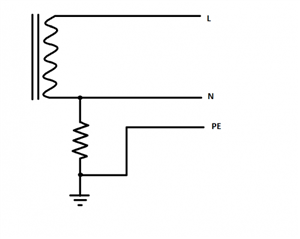
As earth fault currents would be low, you'd need RCDs for ADS (just like a TT system), but the way the earthing is connected would seem to give a number of advantages over normal TT or TN systems. The most obvious perhaps is that exposed-conductive-parts remain at (or very close to) true Earth potential even during a L-PE fault - substantially reducing the risks of shock (even for the 5% of the population who aren't necessarily safe under normal ADS) - unlike a TN system where the point of the fault is likely to be at around half the line voltage, and in a TT system anything up to the full line voltage. It also less of an immediate issue if an RCD is a bit sticky or even fails to open altogether. They also claim less risk of damage or fire from L-PE faults than on TN systems - as the fault current is so much reduced.
So firstly what should this system be called? The impedance at the source is like an IT system - but the "T" would mean the consumer has their own earth electrode independent of the source's - which very specifically isn't the case here. Neither is the consumer's PE conductors directly connected to the system neutral which an "N" would usually indicate. As far as I know there isn't a letter to say the consumer's earth is connected directly to the supply's means of earthing (and not N) - maybe we could use "E" or "PE" for that - making it a IPE or IE system? I'm sure there are some better ideas out there.
My other thought was how would such an arrangement fair from the point of view of things like EMI or the effectiveness of SPDs - would it make any difference?
- Andy.
